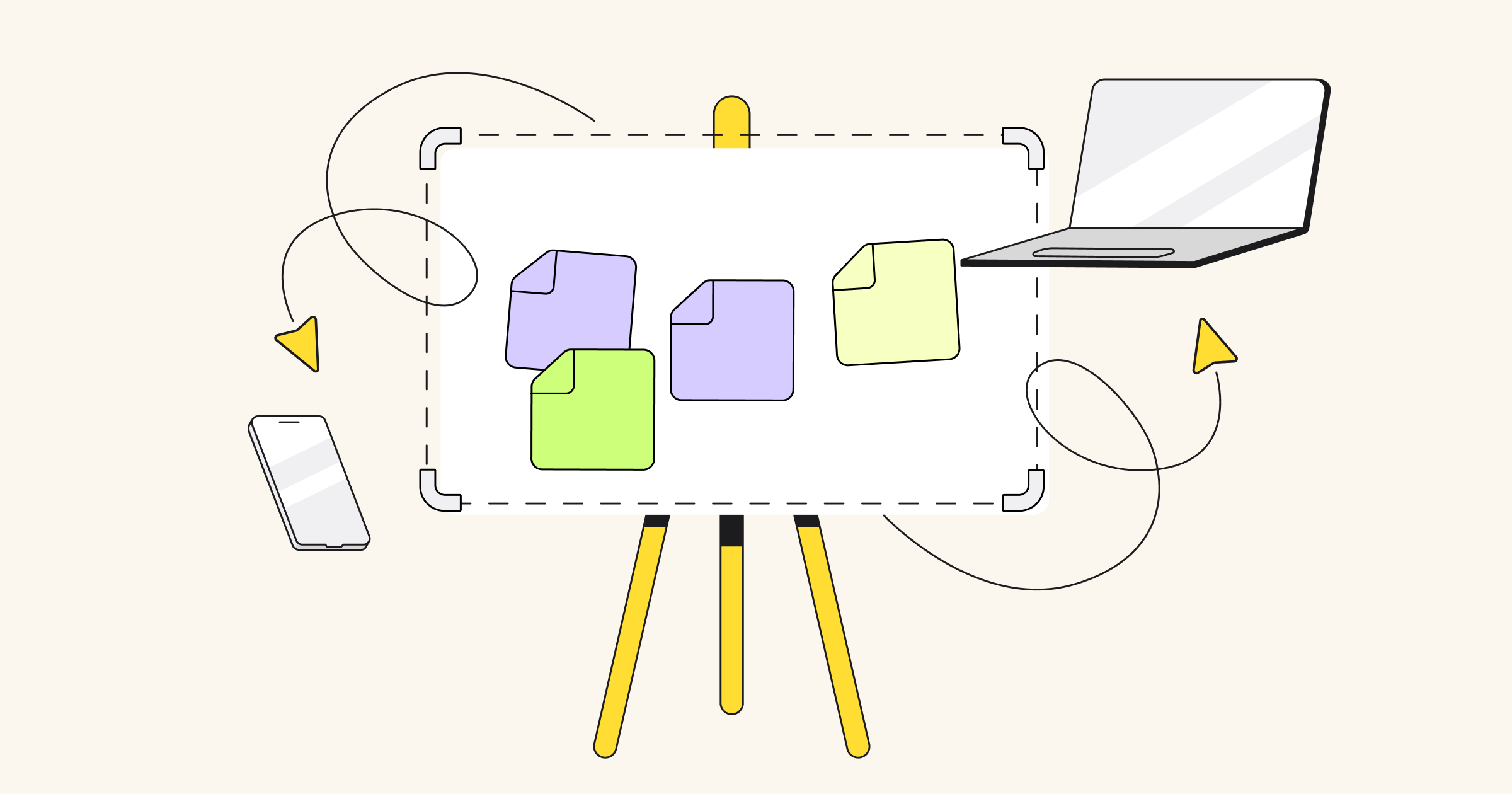Innovation. It doesn’t come easy.
Tales of revolutionary products built in basements sprung from one brilliant idea that has taken on almost mythical status. In fact, they’ve even become Oscar-winning movies.
But product innovation isn’t always the stuff of Hollywood legend. In fact, it’s an organized, detailed, and sometimes painstaking process that is usually left out of the movie.
Read our recent post with brainstorming techniques, rules, and tips for successful brainstorming in teams.
What really happens between “Let’s Make Something Brilliant” and “We’ve Got the Next Big Thing”? In this guide, we provide the answers, including solutions that transform the process of innovation from painstaking to inspiring.
You might also be interested in reading our post on the four collaboration trends driving virtual whiteboard adoption.
It all begins with an idea. Let’s talk for a minute about what that really means for Agile product teams.
Ideation is the process of generating ideas, its methods provide the tools for creativity to overcome conventional wisdom. Ideation can be the perfect companion to the Agile process for product development, particularly for product owners who want innovation or new great features to drive their results.
Some may argue the opposite, that the agile process and innovation are natural enemies; that by adhering to the agile process, innovation is muted. In this guide, we present evidence to dispute that, highlighting the common pitfalls together with the best strategies for organizing the ideation process in your team, particularly in teams that work remotely.
In fact, we believe merging ideation, through the most popular technique of brainstorming, with the “Think It” phase of the agile methodology is the best way to bring superlative product innovation to fruition. Incorporating brainstorming into the agile process simplifies decision-making by providing the clearest path to success.
Our essential guide to Brainstorming will guide product teams through the process of generating great ideas. Due to the reality of remote teams, our guide will spend time discussing the best avenues remote teams should take to make the most of a brainstorming session.
6 business trends that affected brainstorming
Can you picture Don Draper, Peggy, and the creative team gathered around their drafting tables? Many episodes of Mad Men were centered around late-night brainstorming sessions.
Brainstorming was developed by advertising pioneer Alex F. Osborn in the golden era of advertising. As a leader in his industry, he developed advertising for BF Goodrich, Chrysler, and GE, amongst others. But beyond advertising fame, he is most well known for his development of brainstorming, along with his two golden rules, “Do Not Criticize” and “Every Idea is a Good One.”
Now, almost 60 years later, the practice or “art” of brainstorming has evolved along with our business practices. What would he think of remote brainstorming and agile methodology; the brilliance of modern engineering and inspired product design? Let’s look at 6 recent developments that have revolutionized Mr. Osborn’s “original release”.
Trend 1. Everything’s moving faster
Ask any CEO to list their top goals for 2017 and odds are one, if not all of them will include doing things faster. The hyperactivity associated with online sales, new apps, and changing technologies is driving exponential growth and it’s happening faster than ever. “Going Viral” is a goal, and the more likes in the shortest amount of time wins.
For innovative firms, speed is woven into the culture, primarily because there is no alternative. With new apps and technologies popping up daily, odds are if you don’t get your product launched first, someone else will.
Speed to Market is critical, but it’s not the shareholders driving demand, it’s the rest of us. To meet the ever-demanding needs of users, product teams not only need to come up with a great product, but they need to do it ASAP. So, what does that mean for brainstorming?
Product managers, designers, developers, and agile coaches need to speed things up. Hence the evolution of the Design Sprint, which was developed by Google Ventures in 2010. But brainstorming has also gotten faster. A Design Sprint is a methodology that provides the team the structure and techniques to quickly solve problems or develop ideas within a 2-5 day timeline.
Way back when Mr. O was running his brainstorming sessions, they typically consisted of a large group of 20-30 people all taking turns shouting out one idea at a time.
It was a snoozefest. And today, your Twitter feed-obsessed teammates would be on their iPhones and scrolling in no time. To keep teams on their toes, the best brainstorming processes have also become faster and more engaging.
Trend 2. Remote workers are disrupting the team structure status quo
Another disruption to old-school brainstorming sessions was the reduced number of attendees in the conference room. When you envision “brainstorming”, what comes to mind? You may automatically envision a whiteboard with a bunch of sticky notes and wipe-off markers.
What’s occurred over the last 10 years is a shift from local offices to distributed teams.
The idea of everyone meeting around one table is becoming obsolete for most of us. Co-workers are located around the globe, speak different languages, and live in different time zones.
With more and more teammates located outside the home office, Agile coaches, Scrum masters or product managers need to look for brainstorming methods and tools that can overcome these challenges:
- Lack of opportunity to contribute
- Language and time zone differences
- Disengagement and lack of interest
As more and more teams are made up of remote team members, “Old School” brainstorming tools and processes have evolved to keep the entire team engaged and contributing equally.
Trend 3. You’ve got the whole world on your shoulders
Odds are that your product is sold globally. Will it work as well in Tokyo, Japan, as it does in Tallahassee, Florida? An online brainstorming session with co-workers in both countries just might bring potential problems to light and help you build a winning MVP (minimum viable product).
Your business responsibilities have grown and so have the challenges that come along with it. You’ve got to manage research, feature releases, engineering, user interfaces — the list is endless.
Here’s the thing: sometimes, the simplest of brainstorming methods elicit the best results. But how can you apply them to multi-layered, complex problems? To convince stakeholders to invest or commit to your teams’ recommendations, a robust tool needs to be used.
To solve the challenges your team is facing, the product owner needs to include a mixed cross-section of functional teams, stakeholders, users, and partners. This adds an extra layer to the complexity of remote brainstorming.
We’ve all probably repeated the following, inside our heads like a mantra, “Please don’t say I have to include remote teammates, please don’t say I have to include remote teammates”. You know you have! Don’t fret. The evolution of brainstorming has made it easier than ever to include all the important members of the team with ease and keep everyone happy, productive, and engaged.
Trend 4. The Agile process boom and its effect on brainstorming
Today, the Agile process and brainstorming go hand in hand. They are companion methodologies that merged during the rise in popularity of the Agile process.
The Agile process became popular in the 1990’s, due to its effectiveness and the changing role of technology in business. This evolution had a big impact on the methodologies associated with brainstorming.
Agile practices drove the advent of mobile technology, and apps present “feature releases” and put pressure on teams to move fast and deliver great results. By incorporating brainstorming into the process, particularly in the “Think It” and “Tweak It” stages of the agile process, engineers, designers, and managers realized the following benefits:
- Weak ideas can be discarded more quickly
- More and improved ideas are generated
- Team and management gain clarity leading to improved decision-making
Trying new brainstorming methods and tools can also help inspire and engage the team to achieve great results from sprint to sprint.
Trend 5. Communication overload: media instability
We’re all connected now. A non-stop barrage of media is coming at us all day long and more and more of that content is being delivered through new apps that arise just as you settle into a comfortable understanding of the previous. The rise of video and photo technology has completely shifted the way a brand is perceived today.
Most of us reading this guide operate within a similar cultural society; we’re tech-savvy and early adopters. But the products we develop need to be designed for an end user very different from ourselves. Does your product and features align with the perception the end-user has of your brand? Success depends on the end user’s perception of the product. What is the world around us telling them? Is it available on your product?
Organizations need to have a complete awareness of the what, when, where, and how of their brand in each business communication. Messaging, branding, voice, and images need to be constantly reinforced through social media with the caveat that it can all change on a dime.
There is no “safe zone” for marketing and product owners any longer. With communications flowing around you at the speed of light, product owners need to be able to quickly respond to anything thrown at them.
Succeeding in an unstable environment can be tricky and requires vigilance. How can you manage it all? With brainstorming sessions that operate on the same level, you’ve got words, video, images and more all coming at you… Older forms of brainstorming can’t handle the variety of media we are surrounded with today, hence the need for something better.
Trend 6. Technology
The advent of technology changed everything and will continue to do so. There is no greater influence on the evolution of brainstorming than the shift to online operations. And we don’t just mean computers.
Today, we’re all moving business to the cloud, talking about subscription services, and maintaining data security every step of the way. Keeping abreast of technological advances requires a lot more in-depth preparation and caution.
The leaps and bounds of online operations required the methods of brainstorming to shift from physical whiteboards to online whiteboards. Your customer is online, and your remote team is online. Engineers work “together” in India, Russia, and Silicon Valley. Where should your brainstorming session take place? It only makes sense to house your brainstorming session within an online framework.
If some of your brainstorming methods haven’t adjusted along with the rest of today’s influences, this could be a potential roadblock to success. But don’t fret. In the next chapters, we will examine brainstorming fails and how they can be fixed.






